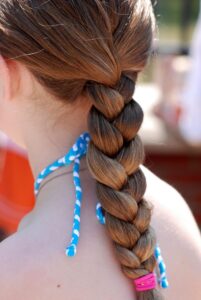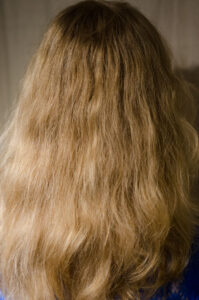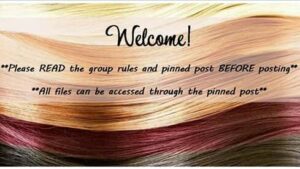 Hair care has been a big thing for me recently. I haven’t used shampoo in about two years, but about two months ago I had to change things up, and discussions on Facebook have me thinking about it more. Hair is another source of chemical allergy transfer, as it “catches” allergens in the air and then rubs against the skin.
Hair care has been a big thing for me recently. I haven’t used shampoo in about two years, but about two months ago I had to change things up, and discussions on Facebook have me thinking about it more. Hair is another source of chemical allergy transfer, as it “catches” allergens in the air and then rubs against the skin.
History
I have fine, blonde hair, with a semi-wave that makes hair stylists think it’s curly, but it won’t hold a curl. My hair is thin, but the body and quantity of hair make people think I have more of it than I do. My hair has never been dyed, and I only permed it once, in elementary school. This hair’s about as unprocessed as it can get.
I stopped using shampoo because I always had a dry, itchy scalp, and even shampoos designed to treat exactly that only seemed to continue the problem. I eventually saw the logic of not washing so much oil (moisture) out only to put more things back in, and dropped shampoo for good. When I first stopped using shampoo, I stopped cold turkey and immediately used my head as a testing ground for all sorts of homemade concoctions. One clay mixture finally (6 months later) hit the jackpot for me, in that my hair didn’t look greasy anymore and my scalp stopped itching. I had finally found something that worked and gotten through the transition period from hell. I still have that clay mixture, but I may not go back at this point.
The Allergy Discovery
 When I found out I had allergies to isothiazolinones, it was kind of an *aha!* moment in discovering why the shampoos had been so bad for me. I also realized that the allergens in the air affect me and stick to my skin and hair just as much as when I touch them. I struggled to figure out if having my hair down was better, allowing my hair to cover and protect some of my neck, or whether hair up would keep my allergen-absorbing hair from rubbing against tender skin and transferring problems. I decided on up. The one thing I was sure about was that I needed to at least rinse and rub my hair every time I came home, to clean it.
When I found out I had allergies to isothiazolinones, it was kind of an *aha!* moment in discovering why the shampoos had been so bad for me. I also realized that the allergens in the air affect me and stick to my skin and hair just as much as when I touch them. I struggled to figure out if having my hair down was better, allowing my hair to cover and protect some of my neck, or whether hair up would keep my allergen-absorbing hair from rubbing against tender skin and transferring problems. I decided on up. The one thing I was sure about was that I needed to at least rinse and rub my hair every time I came home, to clean it.
More Recently
About two months ago, my scalp got so itchy, again, that I went searching for more answers. Amongst the couple of dozen options I found, some basic ones stood out: borax, peroxide, apple cider vinegar, and epsom salts. Why did these stand out? Well, they were all things I already had in my home. None should leave much if any of a residue, and I’d already been using them in one way or another in my home, so I knew they could be used reasonably safely. I first tried the complicated mixture of small amounts of both apple cider vinegar and peroxide in a large volume of water, followed by a saturated solution of borax, then rinse out with very warm water, and then rinse in cold. Not only was it way too many steps, but it dried out my scalp like crazy! My scalp was peeling, and otherwise no better than before. It was meant to kill fungus on the scalp, but it had probably done that, and the itch remained.
A Solution
 I then decided to try the epsom salts. Borax was working to remove excess oils, but I reduced the quantity to about a tablespoon in 500 mL of very warm water once a week or so. I put it in, rub my head and hair for 20 seconds, then rinse out with warm water. Each time I have to rinse or wash my hair throughout the week, I mix 1/2 cup of epsom salts in one litre of warm water. I leave on about 30-45 seconds at most, then rub and rinse my hair out. No matter whether I’m using borax and epsom salt or just epsom salts, I always do my final rinse in cold water to smooth out my cuticle. The sulphur content of the epsom salts seems to work like a dandruff shampoo to help reduce the cause of the itching. This is working now. My hair is shinier and has more body than it even had before I stopped shampoo. My wave is back, and my scalp doesn’t flake anymore.
I then decided to try the epsom salts. Borax was working to remove excess oils, but I reduced the quantity to about a tablespoon in 500 mL of very warm water once a week or so. I put it in, rub my head and hair for 20 seconds, then rinse out with warm water. Each time I have to rinse or wash my hair throughout the week, I mix 1/2 cup of epsom salts in one litre of warm water. I leave on about 30-45 seconds at most, then rub and rinse my hair out. No matter whether I’m using borax and epsom salt or just epsom salts, I always do my final rinse in cold water to smooth out my cuticle. The sulphur content of the epsom salts seems to work like a dandruff shampoo to help reduce the cause of the itching. This is working now. My hair is shinier and has more body than it even had before I stopped shampoo. My wave is back, and my scalp doesn’t flake anymore.
Everyone’s hair and scalp are different, but if you’re having allergy issues, losing the shampoo IS an option, for almost everyone. Because everyone’s hair is different, one solution will never fit everyone. One solution may not even fit one person for more than a year or two at a time. Changing to non-shampoo options always causes at least some form of transition period during which hats, scarves, and ponytails are your friend, but once you find the right solution, it will pass. The result will be lower scalp sebum production, resulting in you needing to wash your hair less frequently. I even have fewer split ends. There are multiple product options for every hair cleaning remedy out there:
“Low-poo” – Reduced detergent surfactant and chemical content products only
“OH-poo” – Soap-based surfactant only (OH stands for the hydroxyl group of oxygen and hydrogen in the lye used to make soap)
“Co-wash” – Emulsifying scalp sebum in conditioner only washes
“No-poo” – Using only non-soap and non-detergent products, usually single-ingredient household items
“Water only” – Exactly as described.
“Baking soda and vinegar” – Washing with heavily diluted baking soda, and rinsing with heavily diluted vinegar, usually raw apple cider vinegar (ACV)
“Scritching and preening” – Using fingers or a very fine comb to rub the scalp and spread oils down the hair shaft towards the ends

Source: Facebook
I only have knowledge about the things I have personally tried, but Google searches on each of the terms above should provide ample information about the specifics of each method. Another good source of information is the Facebook group, “No Poo (no shampoo) & Low-poo Hair Care Group Forum“. The topic is simply too broad for me to even begin to cover it here.
Have allergies or other reasons caused you to drop shampoo from your hair care routine? What are you using and why? Comment below.

Thank you for tip of wearing hair up. It’s really helped.